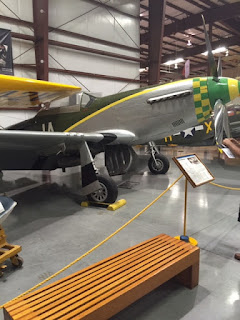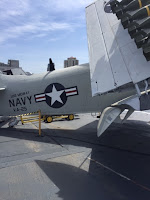I have long known that San Diego was the home of Consolidated Aircraft, later Convair, which built some of America's strategic bombers, flying boats, jet interceptors, and space rockets and missiles during World War II and the Cold War. However, even though San Diego has its own aerospace museum, the San Diego Aerospace Museum, I did not visit the museum until the summer of 2011. I've gone to the museum again since a number of times, most recently in September 2017. Therefore, I wanted to discuss highlights from my last visit to the SDAM as they relate to aviation development in Southern California, including San Diego.
 |
Top: Convair YF2Y-1 Sea Dart (BuNo 135763) flanking entrance to San Diego Aerospace Museum
Bottom: Convair XF2Y-1 Sea Dart during flight testing in San Diego Bay
|
The most noticeable sight that I've noticed as I walk into the San Diego Aerospace Museum is a pair of planes mounted on pedestals -- a Convair F2Y Sea Dart seaplane fighter and a Lockheed A-12 spy plane. While the A-12 is better known as the precursor of the famous SR-71 Blackbird, the F2Y Sea Dart is quite notable as one of a few designs in the world for a seaplane jet fighter. The F2Y was conceived in the early years of the Cold War in response to a US Navy requirement for a supersonic seaplane fighter, largely in response to whether supersonic aircraft could be made to operate from carriers. Convair specialized in the design of delta-wing aircraft, namely the XF-92, F-102 Delta Dagger, F-106 Delta Dart, and B-58 Hustler, and the design philosophy for these aircraft was carried over to the new seaplane fighter, designated F2Y (FY was allocated to Convair's tail-sitting VTOL fighter). The Sea Dart first flew on January 14, 1953, and flight tests were conducted involving various ski configurations, including a single-ski configuration. The F2Y became the first (and only) seaplane fighter to go supersonic, with the first YF2Y (BuNo
135762) breaking the sound barrier on August 3, 1954 in a shallow dive. However, this aircraft was tragically lost in an accident on November 4 while carrying out flight demonstrations over San Diego Bay, killing test pilot Charles Richbourg. Although an interesting design, the F2Y was cancelled without entering production as the Navy solved problems dealing with operating supersonic jet fighters from large carriers. Nonetheless, the Sea Dart remains a valuable piece of aviation heritage from San Diego because it was the only US jet fighter built to operate from water.
 |
Northrop Grumman MQ-8B Fire Scout unmanned rotorcraft and RQ-4 Global Hawk long-range, high-altitude UAV on display inside San Diego Aerospace Museum. A Ryan B-5 Brougham and BQM-74F Chukar III drone are in the foreground.
|
San Diego is also home to General Atomics, which has manufactured the Predator and Reaper drones that have been used since 9/11 to take out terrorists in Yemen, Afghanistan, and other hotspots in the fight against Islamic extremism, and the museum has a Predator drone on display, but it also features unmanned aircraft built by the Northrop Grumman Corporation, whose aerospace division is located in southern California. The RQ-4 Global Hawk long-endurance UAV (first developed by Teledyne Ryan before that company was acquired by Northrop Grumman in 1999) is the most prolific high-altitude surveillance drone in service with the Air Force, relying on synthetic aperture radar and sensors to spy on enemy territory over an area of 40,000 square miles at an altitude of 60,000 feet. It first flew on February 28, 1998, and during service tests flew surveillance missions over Afghanistan in the early stages of Operation Enduring Freedom; Global Hawks have since overflown not only Afghanistan but also the Middle East. The Navy has adapted the Global Hawk for use as an ocean reconnaissance platform, the MQ-4C Triton, which complements P-8 Poseidon patrol aircraft over high seas. Another Northrop Grumman drone at the museum that struck me was the MQ-8 Fire Scout unmanned rotorcraft. The MQ-8 is one of a growing fleet of unmanned air vehicles designed to take off and land like a helicopter, and it is widely used for reconnaissance, situational awareness, and aerial fire & support and precision targeting support for air, sea, and land forces. Based on the Schweizer 330 helicopter, it first flew in 2000 and has become the premier US Navy unmanned rotorcraft; the MQ-8C version is based on the Bell 407 and has enhanced range, endurance, and payload capacity.
Although the Ryan NYP (
Spirit of St. Louis) is best known for being flown by Charles Lindbergh in 1927 to accomplish the first solo transatlantic flight from New York to Paris, it is noteworthy to point out that the NYP shares its design heritage with another plane built by the Ryan Aeronautical Corporation based in San Diego, the B-5 Brougham. The B-5, like the NYP, was a high-wing, strut-braced monoplane of all-metal design, but was used as an airliner. The Ryan company would later go on to build a number of airplanes, including the Navion light aircraft, ST sports aircraft, PT-22 Recruit trainer, and FR Fireball and F2R Dark Shark mixed power fighters, but the most well-known flying machine built by the Ryan company after 1945 was the Firebee, of which over 7,000 were built. Firebee drones were used for reconnaissance over Vietnam (AQM-34/Model 147 variant), being launched from DC-130 drone control aircraft. The Firebee drone on display at the SDAM is the supersonic BQM-34F, which could fly at Mach 1.5 and flew in 1972. The supersonic Firebees were retired in 1990, but some subsonic BQM-34 drones continued to serve in the early 2000s, seeing combat in the Iraq War, although they have since been replaced by the newer BQM-167 Skeeter drone. Teledyne Ryan was absorbed by Northrop Grumman in 1999.
 
|
North American P-51D Mustang "Bunnie" s/n 44-73683 in WW2 gallery (left) and Douglas A-4B Skyhawk BuNo 142905 in Modern Age gallery (right).
|
Although much of the display halls in the annular section of the SDAM feature aircraft from the dawn of flight, WW1, and the Golden Age, my tour of the WW2 gallery and Modern Age gallery offered me sights of a handful of planes built in southern California in the World War II and Cold War periods. The P-51 Mustang that I saw is one of the most recognizable exhibits in the WW2 gallery because it was the quintessential American fighter plane of World War II, with over 10,000 aircraft produced. Designed by Edgar Schmued (1899-1985) and flown in 1940, the P-51 was second to the Grumman F6F Hellcat in the number of Axis aircraft destroyed by the Allies (4.950 planes destroyed by the P-51 vs. 5,223 destroyed by the Hellcat). Early versions of the Mustang (including the A-36 Apache ground attack variant) more powerful Rolls-Royce Merlin piston engine as the Royal Air Force judged the V-1710 to handicap the Mustang's performance in high-altitude combat operations. The Douglas A-4 Skyhawk (originally A4D) was quite interesting because it was the most prolific attack aircraft design of American aircraft designer Ed Heinemann (1908-1991) after the SBD Dauntless and AD/A-1 Skyraider. Nicknamed the "Hot Rod", the Skyhawk flew in 1954 and served as the Navy's lightweight attack aircraft until the arrival of the A-7 Corsair II in the late 1960s, with 2,960 built. The Skyhawk no longer serves with its country of origin, but still flies with the Argentine Air Force and the Brazilian Navy.
 |
Gallery of Convair aircraft and desktop models of an Atlas ICBM (left), F-106 Delta Dart (middle), and B-24 Liberator (right)
|
One of the interesting sights I encountered in the museum hall was a display of the history of Convair, including models of Convair products and photos highlighting Convair's heyday as an aerospace company and some little-known Convair products. The B-24 Liberator stands out as the best-known Convair product of WW2 because it was more mass-produced than the B-17, while the F-102 and F-106 epitomized the Air Defense Command's efforts to defend the US mainland from Soviet bombers. The Atlas ICBM (originally designated SM-65, later CGM/HGM-16) was the first American ICBM ever built, but its career as a missile was brief compared to the Titan and Minuteman, so it ended up as a space launch vehicle for most of its career, launching the first American into orbit (John Glenn) and ferrying a plethora of spacecraft into space including reconnaissance satellites, interplanetary probes, and weather and navigation satellites. I happened to notice a photo in the display of the Convair YB-60, a jet-powered derivative of the giant B-36 Peacemaker intercontinental bomber that served as Convair's rival to the B-52 Stratofortress. The YB-60 was judged inferior to the B-52 in speed and the Boeing ship was chosen for production, freeing Convair to develop the first American supersonic bomber, the B-58 Hustler.
 
|
Consolidated PBY-5A Catalina on display at Edwin D. McKellar Pavilion of Flight (left); Catalina flying boat on patrol over North Atlantic, early 1940s (right).
|
While taking a tour of the Edwin D. McKellar Pavilion of Flight, I came upon a Consolidated PBY Catalina flying boat mounted on a pedestal. The flying boat impressed me, especially with the nature of the landing mechanism and the wing arrangement. The PBY Catalina was the most widely used American flying boat of World War II, with over 3,300 built, and Catalinas played a vital role in the fight against "wolfpacks" of German U-boats in the North Atlantic and patrolled the Atlantic and Pacific Oceans in the war. The PBY-5 I saw was the most mass-produced Catalina version (1,486 built), and the PBY was named in honor of Catalina Island. A number of Catalina flying boats are still in use as waterbomber aircraft designed for firefighting operations.








































